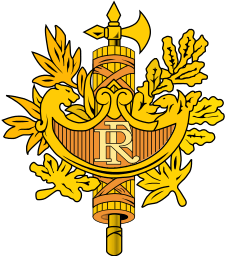France–India relations
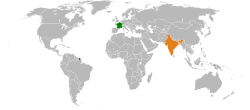 |
|
France |
India |
|---|---|
| Envoy | |
| Ambassador François Richier | Ambassador Arun Kumar Sinha |

France–India relations have traditionally been close and friendly. With the establishment of the strategic partnership in 1998, there has been a significant progress in all areas of bilateral cooperation through regular high-level exchanges at the Head of State/Head of Government levels and growing commercial exchanges including in strategic areas such as defence, nuclear energy and space. France was the first country with which India entered into an agreement on nuclear energy following the waiver given by International Atomic Energy Agency and the Nuclear Suppliers’ Group enabling India to resume full civil nuclear cooperation with the international community. There is also a growing and wide-ranging cooperation in areas such as trade and investment, culture, science & technology and education. France has consistently supported India’s permanent membership of the UNSC. Both India and France are proponents of a multipolar world led by regional democracies.
Puducherry, a former French colony, is a popular tourism destination for French travellers to India.
History

In the 17th century François Bernier (1625–1688), a French physician and traveler, became for 12 years the personal physician of the Mughal emperor Aurangzeb.
In the 18th century, France was actively involved in the powerplay in India. The French military adventurer, Benoît de Boigne, made his name in India under the service of Maratha Empire, whom he assisted in many battles against the British East India Company.[1]
The French General Dupleix was allied to Murzapha Jung in the Deccan, and Chanda Sahib in the Carnatic Wars, in the conflict against Robert Clive of the East India Company. These relationships were beneficial to the French, and French allies gifted areas such as the Alamparai Fort in return for the services provided by the French against the British.

The French succeeded in the 1746 Battle of Madras, and the French and Indians fought together and vanquished Anwaruddin in 1749, but failed in the Battle of Arcot in 1751 and finally surrendered in 1752.[2] The French again had a success at the capture of Fort St David in 1758 under Lally, but were finally defeated at Machilipatnam (1759) and Vandavasi (1760).[2]
The French military adventurer and mercenary, Benoît de Boigne, made his name in India under the Marathas, whom he assisted in many battles against the British East India Company.[1]
French had lost preeminence in India with the Treaty of Paris (1763), although five trading posts were being maintained there, leaving opportunities for disputes and power-play with Great Britain.[3] France was successful in supporting the American War of Independence in 1776, and wished to expel the British from India as well.[3]
In 1782, Louis XVI sealed an alliance with the Maratha Peshwa Madhav Rao Narayan. As a consequence Bussy moved his troops to Ile de France (Mauritius) and later contributed to the French effort in India in 1783.[3][4] Suffren became the ally of Hyder Ali in the Second Anglo-Mysore War against British rule in India, in 1782-1783, fighting the British fleet on the coasts of India and Ceylon.[5][6] Between February 1782 until June 1783, Suffren fought the English admiral Sir Edward Hughes, and collaborated with the rulers of Mysore.[6][7] An army of 3,000 French soldiers collaborated with Hyder Ali to capture Cuddalore.
While Great Britain established it's authority over the Madras Presidency (covering the modern Indian states of Andhra Pradesh and Tamil Nadu), France retained control of Pondicherry, Karikal, Yanam, and Mahé, as well as maintaining a foothold in Chandannagar, now in West Bengal. dicherry
India in World War I and World War II

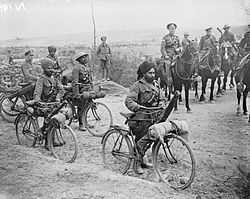
Indian Expeditionary Force A, Indian Army Service Corps and Imperial Service Troops contributed to defend France during World War I and World War II.
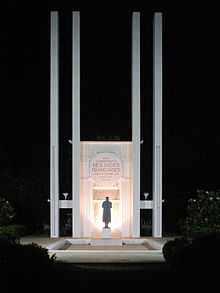
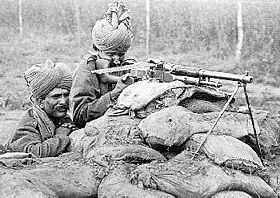
Some of the more prominent battles involving troops from the Indian sub-continent:
- Battle of Neuve Chapelle
- Battle of Armentières
- First Battle of Ypres
- Battle of the Somme
- Battle of Bazentin
- Battle of La Bassée
- Battle of Flers-Courcelette
- Battle of Festubert
- Battle of Aubers Ridge
- Battle of Loos
- Battle of Cambrai
- the advance to the Hindenburg Line
- First Battle of Champagne
Of the 130,000 Indians who served in Somme and Flanders theatre of operations during World War One, almost 9,000 died.[8]
Neuve-Chapelle Indian Memorial, Ayette Indian and Chinese Cemetery, La Chapelette British and Indian Cemetery, Neuville-Sous-Montreuil Indian Cemetery, Gorre British and Indian Cemetery and Zelobes Indian Cemetery are examples of military cemeteries built to commemorate Indian casualties in France.
Darwan Singh Negi, Gabar Singh Negi, Gobind Singh Rathore and Mir Dast were awarded the Victoria Cross for exceptional gallantry on French battlefields.
The Monument aux Morts in Pondicherry was built in memory of colonial troops from French India. Pondicherry responded to the June 1940 appeal by Charles de Gaulle and became the first French territory to abandon the collaborationist Vichy regime and join Free France.[9]
The diversion of food grains from India to supply Allied troops involved in World War II created the Bengal famine of 1943.
Cession of French territories in India
France established diplomatic relations with the newly independent India in 1947. An agreement between France and India in 1948 stipulated that the inhabitants of France's Indian possessions would choose their political future. A treaty of cession was signed by the two countries in May 1956. It was ratified by the French parliament in May 1962. On August 16, 1962 India and France exchanged the instruments of ratification under which France ceded to India full sovereignty over the territories it held. Pondicherry and the other enclaves of Karaikal, Mahe and Yanam came to be administered as the Union Territory of Puducherry from July 1, 1963.
Development of bilateral relations
The bilateral relations with France, although globally positive, fluctuated in function of defence sales to Pakistan (Exocet missiles, Dassault Mirage III, Dassault Mirage 5 & Breguet Atlantic aircraft and Daphné-class & Agosta 90B-class submarines) and were offset by especially strong relations in the fields of civil nuclear energy and aerospace.
In 1998, the then-French President Jacques Chirac made a high-profile visit to transform the relationship with India.[10] In January 2008, French President Nicolas Sarkozy visited India and was the chief guest at India's Republic Day parade.[11] In September 2008, Indian Prime Minister Manmohan Singh made a major visit to France.[12] The Prime Minister of India was the Guest of Honour at the 14 July Bastille Day Celebrations in 2009. French President Sarkozy undertook his second visit to India from 4–7 December 2010. French President Francois Hollande visited India on 14–15 February 2013.
Indian Prime-Minister Narendra Modi was in Paris on 10–11 April 2015 for strategic bilateral discussions with French President François Hollande.[13]
Strategic partnership
The strategic partnership has profited from sustained political investments made at the senior-most levels of decision making. The long-standing relationship between France and India has resulted in extensive co-operation in the domains of aerospace and civil nuclear energy besides military matters. Science & technology cooperation, deep-rooted cultural ties, and a historically francophile literary & fine-arts community in India has provided solid foundations for the strategic relationship. In November 2011, the Foundation for National Security Research in New Delhi published India’s Strategic Partners: A Comparative Assessment and ranked India’s top strategic partners with a score out of 90 points : Russia comes out on top with 62, followed by the United States (58), France (51), UK (41), Germany (37), and Japan (34).[14]
Voting patterns of France in the UN Security Council on matters of core interest to India has endeared the country as all-weather friend of India. France was one of the few nations who did not condemn India's nuclear tests in 1998 and has supported India's bid to become a permanent member of the UN Security Council as well as G-8.[10][11] France is one of the largest suppliers of nuclear fuel to India, and signed a "Framework Agreement for Civil Nuclear Co-operation" in January 2008.[12] After India's waiver from the Nuclear Suppliers Group (NSG), both nations signed an agreement that would pave the way for the sale of French-made nuclear reactors to India on 30 September 2008.[12][15] India has purchased much military equipment from France, especially the French Mirage 2000 fighter aircraft and the Scorpène class submarines.[16] The armed-services of both nations conduct joint-exercises on an annual basis. France and India also maintain a discreet "strategic dialogue" that covers joint cooperation against terrorism. The strategic autonomy of the French Force de frappe resonates well within Indian strategic circles.
French sovereign presence in the Indian Ocean through the French Overseas region of Réunion. The island has a significant ethnic Indian population colloquially called Malbars and which includes all Réunionnais of Indian origin. Réunion's location in the Indian Ocean makes France ideally positioned to leverage advantages of the Neighbourhood first policy and Indian Ocean outreach priorities which were announced by the government of Narendra Modi.
Institutional Structure for dialogue
France and India have instituted a Strategic Dialogue at the level of National Security Advisers whose 24th round took place in New Delhi on 4 September 2012. The latest round of Annual Foreign Office Consultations at the level of Foreign Secretaries was held in New Delhi on 28 June 2012.
Defence
Defense partnership and cooperation is built on historic French and Indian military friendship which stretches back to the Carnatic Wars. India was heavily involved in both World War I and World War II and suffered huge loss of lives on European battlefields.
A 400-strong contingent of the Indian armed forces led the Bastille Day parade in 2009 for which the Prime Minister of India was the Guest of Honour - the first time ever that Indian troops took part in another country’s national day parade.
Under the framework of the structured talks under the Indo-French Defence Cooperation Agreement several meetings on industrial collaboration and service exchanges are held regularly. The High Level Committee for Defence Cooperation (HCDC) at the level of Defence Secretaries, met in New Delhi on 26–27 April 2012. The 3rd meeting of the JWG on Counter-terrorism was held in New Delhi on 19–20 November 2012. The 11th meeting of the Indo-French Research Forum (IFRF) was held in Paris from 17–19 December 2012.

Indo-French Air Force Exercise Garuda IV was held at Istres air base in France from 14–25 June 2010. Indo-French Joint Naval Exercise Varuna was held in the Mediterranean sea off the port of Toulon from 19–22 July 2012. The first Indo-France joint army exercise named Shakti was conducted in India at Chaubattia from 9–22 October 2011. In 2013, Army chief General Bikram Singh visited Commandement des Forces Terrestres Land Forces Command in Lille and the French Military School at Draguignan.
Trade & Investment
Indo-French bilateral trade has been growing though it has still not reached the €12 billion target set by both the Governments during the visit of the French President to India in January 2008. In 2011, bilateral trade had increased by 6% to €7.46 billion. In the first ten months of 2012, there has been a decrease of 3.71% in the bilateral trade over the same period of 2011. Based on annual data, the Indian exports of services to France have shown a growth in the last three years reaching €1.32 bn in 2011 while the imports from France fell to €0.66 bn in the same year.
Foreign Direct Investment (FDI)
France is the 9th largest foreign investor in India with a cumulative investment of approximately US$3 billion [Investment was of the order of US$2.98 billion during the period April 2000 to June 2012, which represents 2% of total inflows]. The technical and financial collaborations approved with France number 952. Top sectors attracting FDI inflows from France are Chemicals (other than fertilisers) (18.80%), Cement and Gypsum Products (15.82%), Services Sector (financial & non-financial) (9.41%), Fuels (power & oil refinery) (6.47%) & Electrical Equipments (including computer software & electronics) (5.34%) and auto sector. There are about 800 French companies in India (subsidiaries or JVs, representative offices or branch offices with about 150,000 employees).
In 2011, India was the 13th largest foreign investor in France in terms of project numbers. Indian Investments in France have been growing and Indian companies have invested around €1 billion from April 1996 in different sectors like pharmaceuticals (Ranbaxy and Wockhardt), Software (Tata Consultancy Services, Infosys & Wipro), Wine (Kingfisher), Steel (Tata, Electrosteel), Plastics (Sintex), Railway wagons (Titagarh Wagons), Aerospace (Cades/Axis) & Autoparts (Jyoti) etc.110 Indian-owned companies, including 27 greenfield investments, are present in France and are employing over 5,600 persons.
The Indo-French CEOs Forum, formed in 2009, has been tasked to identify new avenues for cooperation and take initiatives to facilitate business links between both countries. The 16th session of the Joint Committee for Economic and Technical Cooperation, at the level of Ministers of Commerce which deals with issues related to commerce and trade, was held on 23–25 June 2010 in Paris. The fifth meeting of India France CEOs’ Forum was held in New Delhi on 22–23 November 2012.
Aerospace
Aviation
Indian companies are major clients for Airbus & ATR aircraft. Air India, IndiGo Airlines, Jet Airways and AirAsia India host extensive fleets of Airbus passenger aircraft.
France has been a long-standing and reliable supplier of fighter planes and light utility helicopters to the Indian armed services with aircraft such as Breguet Alizé, Dassault Ouragan, Dassault Mystère IV, Sepecat Jaguar, Aerospatiale SA 315B Lama, Aérospatiale Alouette III and Dassault Mirage 2000. France also supplies Turbomeca TM 333 and jointly developed the HAL/Turbomeca Shakti helicopter engines for HAL Dhruv. DRDO 3D Multi-Function Control Radar (MFCR) was developed as part of the Indian anti-ballistic missile programme in cooperation with THALES of France. DCNS is building six Scorpène submarines of INS Kalvari class under a technology transfer agreement at Mazagon Docks in Mumbai.

Dassault Rafale won the Indian MMRCA competition to supply 126 medium multi-role combat aircraft to the Indian Air Force. In February 2015, Indian media speculated that France may abandon the deal due to inabilities to conclude negotiations on contractual obligations.[17]
Space
ISRO and CNES (French National Space Agency) have an umbrella agreement, operating successfully since 1993, under which joint missions like Megha-Tropiques and SARAL have been successfully developed.[18] ISRO has launched French SPOT satellites (Spot-6 & SPOT-7) on PSLV satellite launch vehicles.
Under a commercial Launch Service Agreement between Antrix Corporation Limited (ANTRIX), the commercial arm of ISRO and ASTRIUM SAS, a Company under EADS, France, two advanced Remote Sensing SPOT satellites were successfully launched in 2013 & 2014 on-board ISRO's Polar Satellite Launch Vehicle.
Arianespace based at France has been the major provider of launch services to Indian Geo-Stationary satellites. Subsequent to the launch of APPLE satellite, 18 Indian satellites have been launched by Arianespace. On 7 December 2014, GSAT-16 communication satellite was launched successfully on board an Ariane 5 launcher from Kourou, French Guyana.
Civil Nuclear Energy
A landmark Framework Agreement on Civil Nuclear Cooperation was signed between India and France on 30 September 2008 during the visit of Prime Minister Dr Manmohan Singh to France. Subsequently, during the visit of President Nicolas Sarkozy to India from 4–7 December 2010, the General Framework Agreement and the Early Works Agreement between NPCIL and Areva for implementation of EPR NPP Units at Jaitapur were signed.
Healthcare
Several French firms (Aventis, Rhodia, Pasteur Institute) are active in the life-sciences and medicare sector.
In February 2015, William Haseltine, president of ACCESS Health International and a former professor at Harvard Medical School opined that French healthcare was the best in the world surpassing even Singapore.[19]
Indian life insurance market is the fastest growing in the world and the seventh largest.[20]
Education
Indians spend 7.5% of household income on education.[20]
Education and Science & Technology
Education
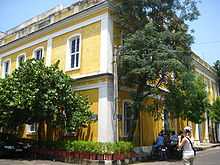
The bilateral educational cooperation between India and France has grown over the last few years. France and India established a Consortrium of Indo-French Universities to increase educational cooperation.[10] Around 300 MoUs have been signed between Indian and French universities and private institutions. The number of Indian students studying in France in various fields has increased over the years. For the academic year 2011-2012, 2550 Indian students came to France.
The framework for bilateral educational cooperation is provided by the Educational Exchange Programme (EEP), which includes mutual recognition of degrees, bolstering the research programme and increasing student-scholar research mobility through a flexible visa regime was signed in 2007 by Joint Secretary, Department of Higher Education, Ministry of Human Resource Development and Secretary, Cooperation and Culture, French Ministry of Foreign Affairs (MFA). A Joint Working Group has also been set up under the EEP. One of the most important initiatives in the field of education has been the cooperation on the new IIT in Rajasthan,following a joint declaration in 2008. A Letter of Intent (LOI) has been signed in 2012.
France operates two scientific research laboratories in India : French Institute of Pondicherry and the École française d'Extrême-Orient (EFEO).
Alliance Française has an extensive network of 19 teaching-centres within India and is very popular for French-language courses and cultural programmes.
Scientific & Technical Cooperation
France and India view each other as important partners in space technology and applications. Indian Space Research Organisation (ISRO) and its French counterpart Centre National de Etudes Spatiales (CNES) have a history of cooperation and collaboration spanning about four decades. Scientific community of both nations cooperate in joint radiation experiment, space components development and space education. Vikas (rocket engine) benefited from Indo-French scientific collaboration on the Arianespace Viking.
The Indo-French Centre for Promotion of Advanced Research (CEFIPRA) is the nodal framework for promoting bilateral scientific cooperation in fundamental and applied research, frontier technologies and exchange of scientists and post doctoral researchers. The office of CEFIPRA has been established in Delhi and the centre is currently funded through an annual corpus of €3 million with India and France equally contributing €1.5 million each. CEFIPRA completes 25 years in 2012. The 25th Anniversary Celebrations of CEFIPRA were formally launched in a programme organised in New Delhi on 6 March 2012. As part of the Silver Jubilee celebrations, a number of programmes have been envisaged; these include holding of seminars, organising science quiz in schools and screening of documentary films.
French authorities have provided land for extending the Maison de l‘Inde in France, which will contribute to augmenting accommodation facilities for Indian students in Paris.
Pasteur Institute in Coonoor, Tamil Nadu which opened on 6 April 1907 is one of the oldest vaccine manufacturing public sectors enterprises in India.
Cultural Exchanges
Indian culture enjoys a wide and discerning audience among the French population, as is evident in the numerous and frequent cultural events organised all over France, spanning the entire gamut of Indian art, music, dance, cinema and literature. While the Indian Council for Cultural Relations (ICCR) sponsors visits of Indian artists to France as also exchange of students in the field of culture and art, there is a growing number of private impresarios who organise cultural events throughout France. A significant number of Indian artists are therefore giving performances in France regularly on a commercial basis or at the initiative of the various local cultural associations outside the purview of the official exchanges. The Indo-French Cultural Exchange Programme (CEP) provides the overall umbrella for the organisation of a variety of cultural programmes. The last (16th) session of the Joint Commission on Culture which reviews the CEP was held on 29 September 2009, in New Delhi.
Namaste France
The 15-month-long Indian cultural festival- “Namaste France" was held from 14 April 2010 to 28 June 2011. It was successful in terms of putting India on the cultural radar of France. ‘Namaste France’ was a comprehensive presentation of Indian culture including art, music, dance, fashion, tourism, films, and literature as also business and education in both its traditional and contemporary forms. The Namaste France Festival was organised in response to ‘Bonjour India’ a similar French cultural festival, organised by the French Embassy in India in 2009-2010. During the visit of Hon’ble Minister of Culture, Housing and Urban Poverty Alleviation, Kumari Selja to Paris to inaugurate the exhibition ‘The Last Harvest – Paintings of Tagore at the prestigious Petit Palais museum from 26 January to 11 March 2012, a Declaration of Intent was signed with her French counterpart for further reinforcing cultural cooperation on 26th January 2012. On the same day, a MOU was signed between the Ministry of Culture of India and the Louvre Museum with the aim of establishing an active partnership in the area of exchange of competencies and expertise, particularly in the field of museology, temporary exhibitions and other cultural events. The 2012 Cannes Film Festival was important for India. For the first time, four Indian films were selected for screening in different categories of the festival namely “Miss Lovely”, “Kalpana”, “Peddlers” and “Gangs of Wasseypur”. India is going to celebrate 100 years of Indian cinema in 2013. The Cannes Festival (15–26 May 2013), the Vesoul International Film Festival of Asian Cinema (Festival international des cinémas d'Asie) from 5–12 February 2013, and the 35th International Short Film Festival of Clermont-Ferrand (1–9 February 2013) have confirmed India as a ‘Country of Honour’ in 2013 to celebrate the Centenary of the Indian Film Industry.
Diaspora
Indian Community in France
The Indian community including NRIs in France is estimated to be around 70,000, largely originating from Puducherry, Karaikal, Yanam, Mahe and Chandranagar. There are also large communities of PIOs in the Reunion Island (about 230,000), Guadeloupe (about 57,000), Martinique (about 5,000) and St Martin (about 3,600-French and Dutch sides), the overseas territories/departments of France.
Indians living in France have access to French social security protection and services through an agreement concluded in 2008.[15]
French Community in India
The French in India are predominantly the remnants of the French presence in India, which began in 1673 with the establishment of French India and continued until 1962 when the French territory was formally transferred to India. The French presence was always small and minor compared with the British Presence and the French in India were generally ignored.
There were 12,864 French nationals residing in India in 1988. Nearly all are in the Union Territory of Puducherry in southeastern India (11,726 individuals in 1988), with much smaller numbers in Karaikal (695 individuals), Mahé (50), Yanam (46), and 342 elsewhere in India. They form a small minority, accounting for less than 3 percent of the present population of Puducherry.
In February 2015, Indo French Senior Citizens Association staged street-protests in Pondicherry to protest against denial of the French nationality and voting rights derived from the 1956 Treaty establishing De Jure Cession of French Establishments in India of French India territories.[21] The 1956 treaty binds the Government of France to recognize French citizenship for individuals whose birth and nativity certificate had been registered during the French India regime.[22]
Economic migration from France has resulted in the rise of skilled French expatriates in the urban population centres of Bangalore, Chennai, Hyderabad, Pune, Mumbai and New Delhi.
Perceptions
BBC World Service Country Rating Poll Data for France & India
According to a 2014 BBC World Service Poll, 35% of Indians view France's influence positively, 40% neutral and 25% expressing a negative view, while 40% of the French view India's influence positively, 11% neutral and 49% expressing a negative view.[23]
| Country polled | Positive | Negative | Neutral | Pos-Neg |
|---|---|---|---|---|
| | 16 | 68 | 16 | -52 |
| | 21 | 58 | 21 | -37 |
| | 20 | 50 | 30 | -30 |
| | 9 | 34 | 57 | -25 |
| | 26 | 37 | 37 | -11 |
| | 36 | 47 | 17 | -11 |
| | 40 | 49 | 11 | -9 |
| | 27 | 35 | 38 | -8 |
| | 38 | 46 | 16 | -8 |
| | 26 | 31 | 43 | -5 |
| | 44 | 46 | 10 | -2 |
| | 45 | 46 | 9 | -1 |
| | 45 | 41 | 14 | 4 |
| | 41 | 36 | 23 | 5 |
| | 35 | 29 | 36 | 6 |
| | 35 | 21 | 44 | 14 |
| | 47 | 24 | 29 | 23 |
| | 34 | 9 | 57 | 25 |
| | 53 | 23 | 24 | 30 |
| | 53 | 22 | 25 | 31 |
| | 56 | 22 | 22 | 34 |
| | 45 | 9 | 46 | 36 |
| | 64 | 22 | 14 | 42 |
| Country polled | Positive | Negative | Neutral | Pos-Neg |
|---|---|---|---|---|
| | 30 | 38 | 32 | -8 |
| | 24 | 18 | 58 | 6 |
| | 35 | 29 | 36 | 6 |
| | 34 | 25 | 41 | 9 |
| | 35 | 25 | 40 | 10 |
| | 35 | 17 | 48 | 18 |
| | 47 | 27 | 26 | 20 |
| | 46 | 24 | 30 | 22 |
| | 46 | 24 | 30 | 22 |
| | 47 | 24 | 29 | 23 |
| | 48 | 22 | 30 | 26 |
| | 55 | 26 | 19 | 29 |
| | 61 | 32 | 7 | 29 |
| | 55 | 25 | 20 | 30 |
| | 38 | 4 | 58 | 32 |
| | 48 | 16 | 36 | 32 |
| | 57 | 24 | 19 | 33 |
| | 51 | 13 | 36 | 38 |
| | 62 | 20 | 18 | 42 |
| | 64 | 20 | 16 | 44 |
| | 70 | 22 | 8 | 48 |
| | 70 | 11 | 19 | 59 |
| | 72 | 9 | 19 | 63 |
See also
- Foreign relations of India
- Indian diaspora in France
- Foreign relations of France
- French people in India
- French Institute of Pondicherry
- India–European Union relations
Notes and references
- ↑ 1.0 1.1 http://en.wikisource.org/wiki/1911_Encyclop%C3%A6dia_Britannica/Boigne,_Beno%C3%AEt_de
- ↑ 2.0 2.1 Cambridge Illustrated Atlas of Warfare, p.160
- ↑ 3.0 3.1 3.2 The National Galleries of Scotland
- ↑ The influence of sea power upon history, 1660–1783 by Alfred Thayer Mahan p.461
- ↑ The History Project, University of California
- ↑ 6.0 6.1 Britain as a military power, 1688-1815 by Jeremy Black, p
- ↑ Cambridge Illustrated Atlas of Warfare, p.159
- ↑ "Commonwealth War Graves Commission Report on India 2007–2008" (PDF). Commonwealth War Graves Commission. Retrieved 2009-09-07.
- ↑ ‘Victory in Europe Day’ observed in Pondicherry
- ↑ 10.0 10.1 10.2 "India-France relations set to move into high gear". Indiainfo.com. 2008-09-27. Retrieved 2008-10-08.
- ↑ 11.0 11.1 "French President witnesses Indian military might". France24. 2008-01-26. Retrieved 2008-10-08.
- ↑ 12.0 12.1 12.2 "India and France in nuclear deal". BBC News. 2008-09-30. Retrieved 2008-10-08.
- ↑ Modi rejigs Europe, Canada itinerary to put Paris first
- ↑ Why Does India Have So Many 'Strategic Partners' and No Allies?
- ↑ 15.0 15.1 "India, France ink landmark nuclear deal". Rediff.com. 2008-09-30. Retrieved 2008-10-08.
- ↑ "India, France Discuss Submarine, Mirage Deals". Arab News. 2003-04-29. Retrieved 2008-10-08.
- ↑ Dassault may abandon $20-bn MMRCA deal
- ↑ ISRO: PSLV C-18
- ↑ "How much do women around the world pay to give birth?". BBC. 13 February 2015.
- ↑ 20.0 20.1 "Credit Suisse introduces the Emerging Consumer Survey". Credit Suisse Research Institute. 17 January 2011.
- ↑ Protest for French nationality, voting rights
- ↑ India-France 1956 Treaty establishing De Jure Cession of French Establishments in India (Indian Ministry for External Affairs)
- ↑ 2014 World Service Poll BBC
- ↑ 24.0 24.1 "BBC World Service poll" (PDF). BBC. 3 June 2014.
External links
- Indian Ministry for External Affairs
- Indian Embassy in France
- Permanent Delegation of India to UNESCO
- French Ministry of Foreign Affairs
- French Embassy in India
| ||||||||||||||||||||||||||||||||||||||||||||||||||||||||||||||||||||||||
| ||||||||||||||||||||||||||||||||||||

